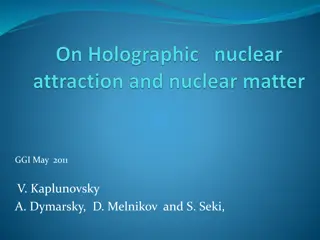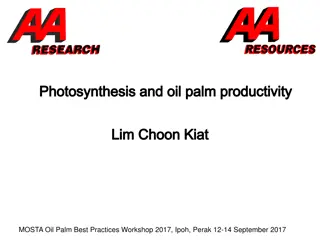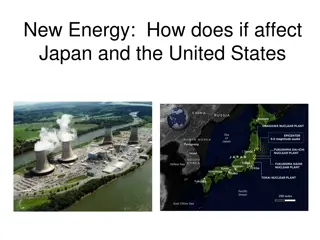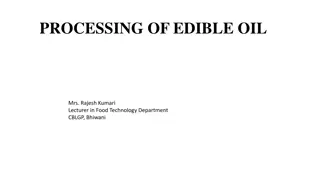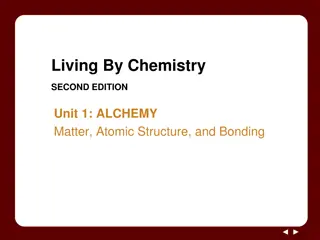Understanding Schlumberger's Nuclear Tools for Oil Exploration
Schlumberger, a global leader in oil exploration, utilizes nuclear physics for assessing rock formations and identifying hydrocarbon reserves. Their innovative tools, like the Spectroscopy Tool for Wireline, allow for accurate measurements and analysis during drilling processes. Recent collaborations with NASA showcase their advanced capabilities in planetary exploration.
Download Presentation

Please find below an Image/Link to download the presentation.
The content on the website is provided AS IS for your information and personal use only. It may not be sold, licensed, or shared on other websites without obtaining consent from the author. Download presentation by click this link. If you encounter any issues during the download, it is possible that the publisher has removed the file from their server.
E N D
Presentation Transcript
Impact of the ENDF/B-VIII.0 Library on Modeling Nuclear Tools for Oil Exploration Marie-Laure Mauborgne, R. J. Radtke, Fabien Haranger Schlumberger MMauborgne@slb.com Schlumberger-Private
What is Schlumberger? Founded in 1927 by a physicist and an engineer to conduct geophysical measurements of rock formations Now: 100,000 employees, >140 nationalities working in >85 countries 125 research and engineering centers world-wide Schlumberger-Private
What are Rocks Made of? Rock = Matrix + Pores Typical matrix materials: In the reservoir sandstone (SiO2), limestone (CaCO3), dolomite (CaMg(CO3)2) Everywhere else shale (e.g. aluminosilicates) Typical pore fluids Salt water (NaCl brine) Hydrocarbon (oil or gas, CnHm) Schlumberger-Private
What Do we Do? We are developing tools to answer basic questions of oil exploration: Where are the hydrocarbons? What kind (oil or gas)? How much can be extracted? Use nuclear physics to measure: Natural radioactivity Rock density Hydrogen index / Porosity Rock matrix and pore fluid composition Hole diameter Schlumberger-Private
How Do we Do it? Various measurements Measurements can be acquired: After drilling the hole, with a tool deployed on a cable which provides power and communication (Wireline) While drilling the hole (Logging while drilling (LWD)) Data are recorded as a function of depth (log) Depth Schlumberger-Private
Spectroscopy Tool for Wireline Diameter: 4 in 11.5 cm Length: 9 ft 3 m Mass: 300 lbm 130 kg 175 C, 20 kpsi rating 1350 atm Uses LaBr3:Ce spectroscopy detector Pulsed Neutron Generator 3.6 x 108 neutron/s nominal First (in the industry) in situ measurement of Total Organic Carbon (TOC) Schlumberger-Private
Recent SLB-NASA Engagements - BECA Spectroscopy on Venus Lander to analyze its crust and look for water Venus surface: P = 92 atm; T = 462 C Operational lifetime: 2-4 h max. First test done at NASA Goddard Space Flight Center with an actual tool. Very good results with only minor modifications of the tool Schlumberger-Private
Recent SLB Space Engagements - DragonFly In collaboration with Johns Hopkins Applied Physics Laboratory Explore Titan (Satune s largest moon) with an instrumented, radioisotope- powered dual-quadcopter Provide pulse neutron generator and expertise on gamma ray spectroscopy to analyze the composition of the shallow sub-surface Credit: Johns Hopkins APL Schlumberger-Private
From Measurements to Elemental Standards Focus on Si, Ca, Mg, Al, Fe, K, S, Na to identify rock matrix H, C, O, Cl to identify pore fluid Extract the spectral signatures of the different elements Acquiring high-precision spectra in variety of environments Combining measured spectra to isolate specific contributions Guiding this process through modeling High-quality elemental standards enable accurate spectral analysis, from which all tool answers are derived: elemental weight fractions, mineralogy, and total organic carbon Schlumberger-Private
Principles of Spectroscopy Measurement Spectral Acquisition Spectral Stripping Composition Mineralogy Inelastic Capture Elemental yields Elemental weight fractions Lithology Pore Fluid Inelastic Capture Schlumberger-Private
Why Do We Need Cross Sections? Nuclear modeling is fundamental to well logging tool development Explore design choices quickly Balance mechanics, electronics and physics without costly experimentation Complement and extend characterization measurements Accurate modeling relies on accurate cross sections Adequate for gamma rays and neutrons transport Improvement needed for neutron-induced gamma rays For spectroscopy, better cross sections would Improve standards derivation and interpretation algorithms May allow elemental standards directly from modeling Schlumberger-Private
How Do We Model the Standards? Use a detailed model of tool geometry 1. Construct the secondary gamma ray source produced by neutrons from the pulsed neutron generator (PNG) 2. Transport the gamma rays back to the detector (mainly through scattering) 3. Apply a detector-specific response map computed by modeling to represent detector response Use a customized version of MCNP to separate contributions from different elements Schlumberger-Private
How Accurate Is Our Modeling? Compare modeling and experiment in the simplest environment: Water Separate spectra acquired after the PNG is turned off (mainly capture reactions) and during the PNG burst (mainly inelastic reactions) Hydrogen peak Electronic threshold Background from the tool Oxygen and escape peaks Schlumberger-Private
Silicon Capture Very good reproduction of the silicon capture spectrum Use of natural compound in ENDF/B- VI, Si-28 afterward Slightly improved with ENDF/B-VIII.0 between 5 and 6.5 MeV Look at modeling response without the detector response Only plot main lines from IEAE capture handbook above 1 MeV Different versions of ENDF are very similar Schlumberger-Private
Silicon Inelastic Use of natural compound in ENDF/B-VI, Si-28 afterward Modeling benchmark is poorer for inelastic Totally different response between ENDF/B-VI and newer releases ENDF/B-VI in better agreement with our experimental results above 7MeV Schlumberger-Private
Iron Capture Iron has been reevaluated through the CIELO collaboration Focus on (n, ) cross section Not on secondary gamma energy spectrum Total count rate is of secondary interest to us Use of Fe-56 cross sections ENDF/B-VII.1 has the best match with experimental data and IAEA capture gamma-ray emission lines ENDF/B-VIII.0 introduces new lines not seen experimentally or in the literature Schlumberger-Private
Manganese Capture Only one isotope found in natural manganese Significantly worse in ENDF/B-VIII.0 ENDF/B-VI and ENDF/B-VII.1 in better agreement with our experimental results and IAEA capture gamma-ray emission lines Schlumberger-Private
Magnesium Capture Natural compound in ENDF/B-VI, break into isotopes afterward Significantly worse in ENDF/BVII.1 and ENDF/B-VIII.0 Gamma ray emission energy are very coarse ENDF/B-VI is just much better for capture! Schlumberger-Private
Magnesium Inelastic Natural compound in ENDF/B-VI, break into isotopes afterward Poorer benchmark compared to capture Gamma ray emission energies are much finer One line at ~1.8 MeV seems to be missing Difficult choice, but the 1.8 MeV line is very distinctive ENDF/B-VI is better for capture Schlumberger-Private
Summary Recommendations for capture gamma ray spectra in the table Element Hydrogen Silicon Calcium Iron Manganese Magnesium Titanium Sodium Chlorine Aluminum ENDF-B/VI ENDF/B-VII.1 ? ? ENDF/B-VIII.0 ? ? ? ? ? For inelastic reaction, benchmark is generally poor Changes in emission spectrum are relatively small Experimental results may not be accurate enough to choose one vs another ? Questionable reproduction of direct measurement Good reproduction of direct measurement Schlumberger-Private
Conclusion The Oilfield industry focuses more and more on secondary gamma ray measurements It is critical to have accurate gamma ray energy lines and related emission cross sections In the last two major releases of ENDF/B, we have seen more degradation than improvement concerning this specific topic Schlumberger-Private










